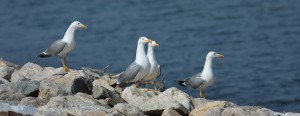Week 27 – 15 January 2017:
Doing the Best With What We Have
Every Sichuan Partridge in China; every Tepui Tinamou in Venezuela; every Chaplin’s Barbet in Zambia… each is ruled by a tiny voice at the back of its head. It is the voice of natural selection, driving it forward. The voice instructs all living creatures to make the maximum possible genetic contribution to following generations. “Reproduce! Reproduce!” cries the tiny voice.
The last 75 years of research has shown that the voice of natural selection is incredibly nuanced. The drive to pass along our genetic legacy is not simply a matter of producing as many offspring as possible, as often as possible. For instance, there is no point in a pair of White-crowned Sparrows producing eight chicks if they can only feed five. A female Welcome Swallow should not produce twelve eggs if all are so small as to be inviable. If a pair of Atlantic Puffins successfully raised three chicks instead of one, but the parents died from exhaustion at the end of the breeding season, the tiny voice would likely be displeased.
In their attempt to pass along their genes, all creatures are faced with tradeoffs. Some of these tradeoffs were illustrated neatly in a recently-published study of Yellow-billed Gulls in northern Africa by Addessalem Hammouda and his colleagues. They observed the reproductive efforts of the gulls at a colony on the Mediterranean coast of Tunisia. At 131 nests, Hammouda et al. noted the days on which each egg was laid, the volume of each egg, and its fate.
The majority of Yellow-billed Gulls at this colony had a three-egg clutch, with a lesser number producing two eggs. The volume of these eggs varied considerably from 61 to 107 ml (2.1 to 3.6 ounces). Hammounda and his team found that the last-laid egg in the clutch was likely to be the smallest. They also discovered that the volume of eggs in three-egg clutches tended to be larger than those in two-egg clutches. Over the 27-day incubation period, 92% of all eggs hatched successfully, but that success was higher among three-egg clutches. What does it all mean?
In the Yellow-billed Gull, last-laid eggs tend to produce the last-hatched chicks. When food is scarce, the slightly-younger, slightly-smaller chicks tends to be outcompeted by their siblings. It seems as though females are investing more resources in their first eggs because those are likely to produce chicks with a higher probability of surviving.
Creating eggs is almost certainly demanding for female birds. It seems that the female gulls that are sufficiently robust to lay three eggs are also in sufficiently good condition to create larger eggs. Females who are able to create three large eggs are also better able to defend those eggs against predation than females producing two smaller eggs. Curiously, terrestrial predators such as snakes and rodents were very rarely seen in the vicinity of the gull colony. However, predation of eggs by other Yellow-billed Gulls was seen frequently.
Although the birds in the Tunisian study were not marked for individual identification, and so the ages of individuals were not known, it is likely that age plays a role in reproductive tradeoffs. Older, more experienced birds are likely better able to acquire resources and defend their nests than younger birds. Beyond that, an individual that is approaching the end of its life may hear the little voice say: “What are you waiting for? This could be your last chance!” Hammouda et al. explained that older females are “likely to have lower residual reproductive potential,” and so should “invest more heavily in current breeding attempts.”
The little voice is subtle, but it is also relentless.
Hammouda, A., F. Hamza, J. Pearce-Duvet and S. Selmi. 2016. Relationship between clutch size, egg volume and hatching success in a Yellow-billed Gull Larus michahellis colony in south-eastern Tunisia. Ostrich 87:139-144.
Photo credits: Yellow-billed Gull stamp - birds-on-stamps.com; photograph of Yellow-billed Gulls by Cosmin-Ovidiu Manci - birds.nature4stock.com



